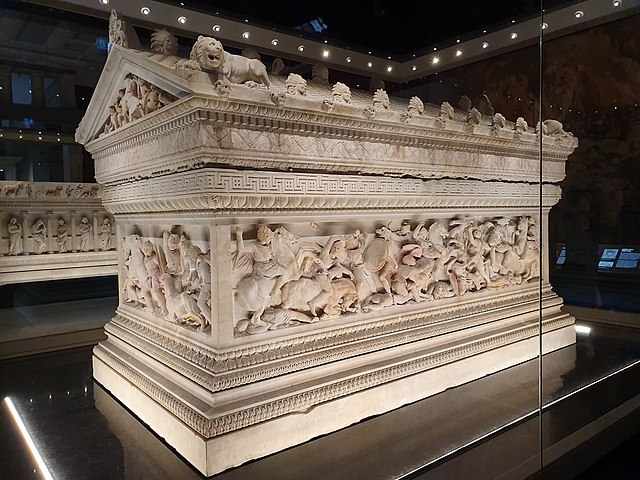Summary
Remarkable Artifact of Antiquity
Known for encapsulating the grandeur of an ancient era, the sarcophagus attributed to Alexander the Great stands as a symbol of artistry and history. Unearthed in the Royal Necropolis of Sidon, it’s adorned with intricate bas-reliefs depicting vivid battle scenes and lions’ heads that project a powerful legacy. Although it’s not certain that Alexander’s remains were ever contained within, this sarcophagus captures the spirit of the Macedonian conqueror’s epoch. Scholars and historians alike celebrate it for its extraordinary craftsmanship and the light it sheds on Hellenistic funerary practices.
Get your dose of History via Email
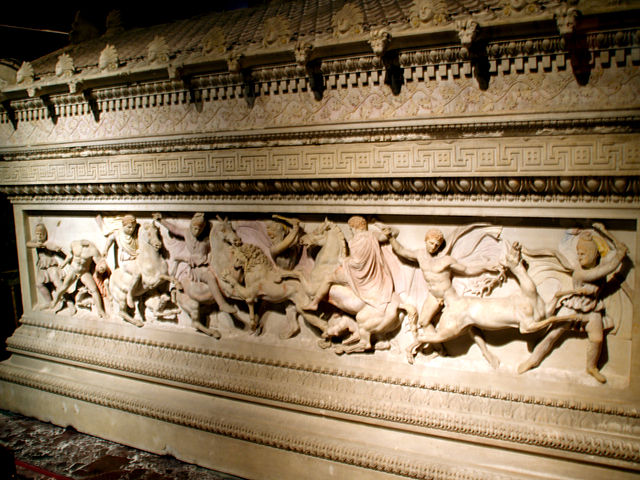
Insightful Glimpse into Hellenistic Culture
The Alexander Sarcophagus is a masterpiece of Hellenistic art. It provides valuable insights into the cultural and societal norms of that period. The scenes carved on it portray not just war, but also reveal aspects of daily life, attire, and weaponry of the time. Its discovery has greatly contributed to our understanding of ancient funerary rituals and has served as an important source for the study of Alexander the Great’s reign. Visitors flock to the Istanbul Archaeology Museums, where it now resides, to step back in time and immerse themselves in the rich tapestry of history it represents.
Timeless Allure for Modern Audiences
Despite being centuries old, the appeal of the Alexander Sarcophagus transcends time. It continues to draw attention for its aesthetic beauty and its link to one of history’s most legendary figures. In a digital age, images and discussions about the sarcophagus flourish online, inspiring curiosity and scholarly debate. It not only enhances our knowledge of the past but also fuels the imagination, inviting modern viewers to ponder the life and times of Alexander the Great and his lasting impact on the world.
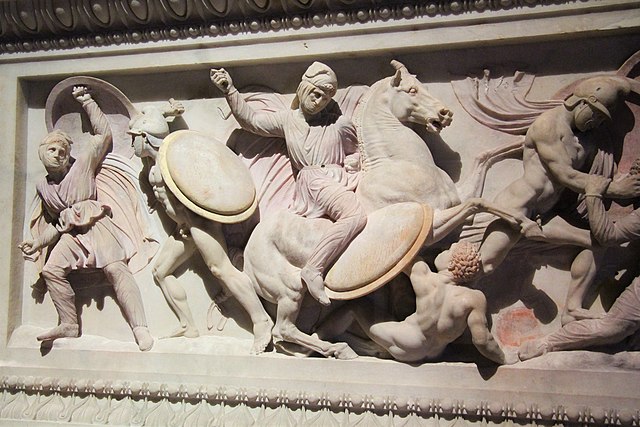
Historical Background of Alexander the Great Sarcophagus
Discovery and Origin
Discovered in 1887 by Osman Hamdi Bey in Sidon, Lebanon, the Alexander Sarcophagus is one of the most significant archaeological finds. Scholars date it to around 320 BC, shortly after the death of Alexander the Great. Although named after Alexander, historians believe it was created for Abdalonymos, a nobleman turned king by Alexander himself. The sarcophagus’s origin is shrouded in mystery, adding to its allure. It tells stories of ancient Sidon and showcases the cross-cultural art forms influenced by the Macedonians, Persians, and Greeks.
Architectural and Artistic Significance
The artwork on the Alexander Sarcophagus is remarkable for its detailed narrative and dynamic composition. Carved from Pentelic marble, the same used for the Parthenon, it displays a fusion of Persian and Greek artistic traditions. The vivid battle scenes suggest craftsmanship of unparalleled skill. The high-relief carvings are so lifelike that they seem about to spring into action. Furthermore, the sarcophagus gives us a glimpse into the attire and equipment of ancient warriors, offering a rare peek into the period’s warfare aesthetics.
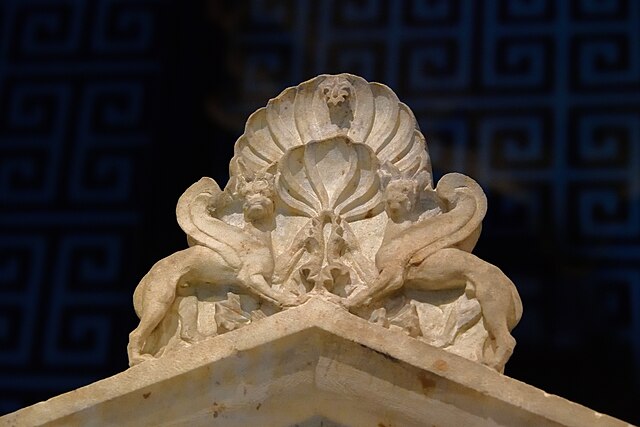
Symbol of Power and Legacy
The Alexander Sarcophagus is more than a burial monument; it is a testament to the power and legacy of Alexander’s empire. The bas-reliefs feature Alexander in battle, possibly the Battle of Issus. These scenes embody the glory and might of his rule. They silently narrate the legacy of a ruler who carved out one of the largest empires of the ancient world. The lions that decorate the corners of the sarcophagus were symbols of power and watchfulness, marking the eternal guard over a fallen hero’s resting place.
Now housed in the Istanbul Archaeology Museum, the sarcophagus continues to impress with its bright colors, partially preserved over millennia. Scholars initially thought the practice of painting marble sculptures was lost to time. The discovery of traces of paint on this sarcophagus revolutionized this understanding, making the sarcophagus a crucial piece in the history of art.
The Alexander Sarcophagus inspires as much as it educates. Its presence in a museum allows millions to marvel at a piece of history that has withstood the test of time. Its intricate design and portrayal of Alexander make it a cornerstone for anyone interested in ancient history, art, and archaeology. It reminds us of the impact one individual can have on the course of history and how their legacy can be immortalized in stone.
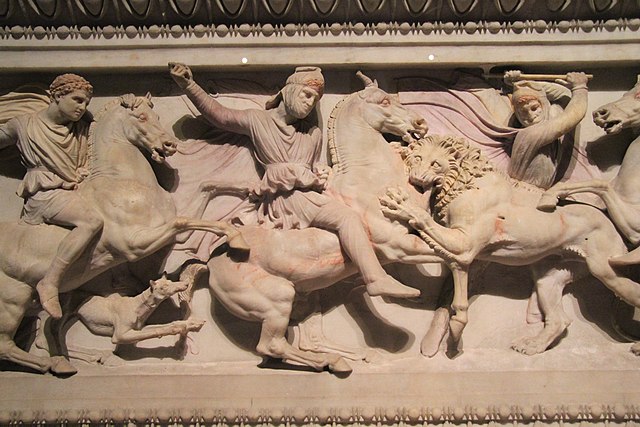
The Discovery of Alexander the Great Sarcophagus
Unearthing a Masterpiece
In the late 19th century, one of the most remarkable findings in archaeological history came to light. During an excavation in Sidon, present-day Lebanon, the Alexander the Great Sarcophagus was discovered. It was 1887, a year that would become etched in history due to this event. Osman Hamdi Bey, a pioneering Ottoman archaeologist, led the excavation. The sarcophagus quickly gained fame for its extraordinary craftsmanship and historical significance.
The Fateful Dig in Sidon
Hamdi Bey’s team unearthed the sarcophagus among many royal tombs in the necropolis of Sidon. The meticulous dig slowly revealed a breathtaking artifact. The Alexander Sarcophagus stood out for its intricate designs. These designs depicted scenes of battle and hunt. The discovery fueled curiosity and wonder among scholars and laymen alike. Additionally, it shed new light on ancient burial practices and Macedonian influence in the region.
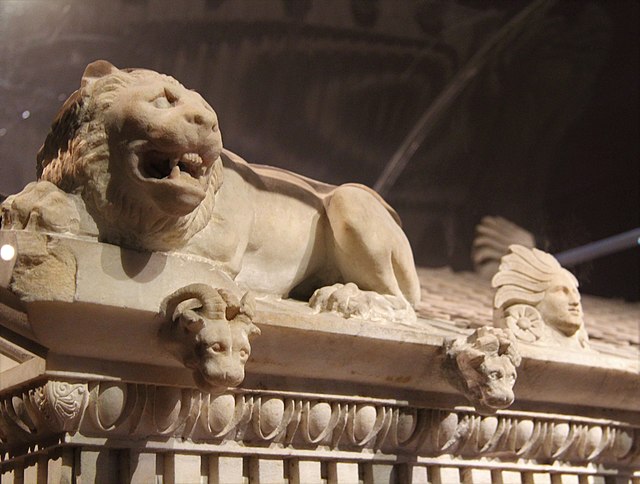
Exceptional Preservation
The sarcophagus was remarkably well-preserved when discovered. Its vibrant colors were still visible after centuries. This preservation added to the excitement. It suggested that ancient Greeks may have painted their marble art, a practice not widely acknowledged before. Conservators and historians took great care in handling the sarcophagus. They aimed to prevent further damage and preserve what remained of the original pigments.
The Alexander Sarcophagus was transported to the Istanbul Archaeology Museum where it remains a significant exhibit. Its journey from its original resting place to a museum display involved careful planning. It also involved execution to ensure its preservation. The sarcophagus drew attention globally. It brought a significant increase in visitors to the museum, eager to view the artifact firsthand.
Today, the sarcophagus continues to be a prominent subject of study and admiration. It represents a merging of cultures from Alexander’s empire. It also showcases the heights of artistic achievement in the ancient world. Its discovery remains a milestone. It underscores the importance of archaeology in understanding and appreciating our shared human heritage.
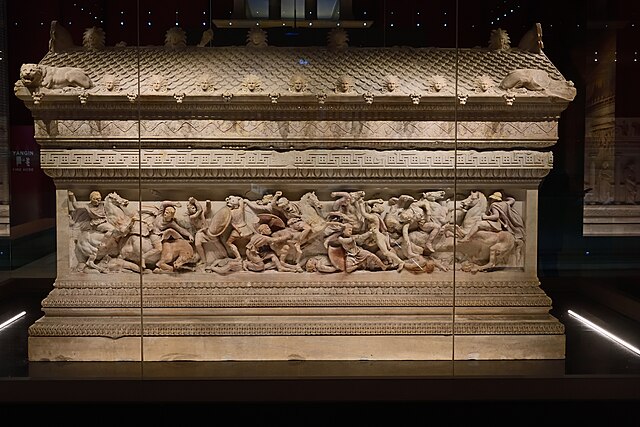
Cultural Significance, Dating methods, Theories and Interpretations
Unlocking the Age of Magnificence
Dating the Alexander Great Sarcophagus has presented a challenge for archaeologists. The accepted timeframe places it around 320 BC. This date closely follows Alexander’s death. Experts determined this through stylistic analysis of the sculpture and reliefs. They also compared it to other artifacts from the era. The motifs on the sarcophagus mirror the Macedonian style of the time. These similarities support the dating. It is crucial for understanding the cultural context in which the sarcophagus was created.
Interpreting the Battle Scenes
The scenes carved into the marble of the Alexander Great Sarcophagus have led to various interpretations. Some scholars suggest that the depictions of battle could be the Battle of Issus. This battle was a significant victory for Alexander against the Persian Empire. Others see it as a broader representation of Alexander’s conquests. These detailed carvings provide insight into the military tactics and equipment used during Alexander’s campaigns. They also illustrate the prowess of ancient artists in narrative storytelling through sculpture.
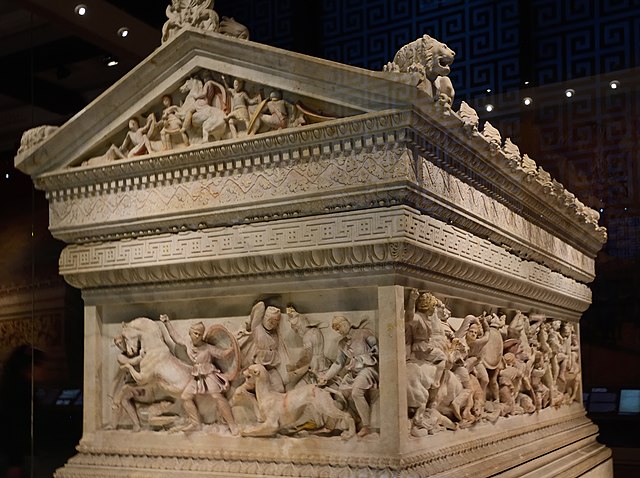
Impact on Hellenistic Art and Culture
The Alexander Sarcophagus holds immense cultural significance. It is considered a high point of Hellenistic art. The fusion of Greek and Eastern styles seen on the sarcophagus mirrors the blending of cultures during Alexander’s conquests. It embodies the spread of Hellenism across his empire. The craftsmanship, themes, and very existence of the sarcophagus also illuminate the importance placed on commemorating the dead with great artistry in Hellenistic society.
Theories about who was actually buried in the sarcophagus continue to be a topic of debate. While named after Alexander the Great, some historians believe it was made for Abdalonymos, an obscure king of Sidon appointed by Alexander. The presence of both Macedonian and Persian soldiers in the reliefs supports the idea of it being a cenotaph for someone close to Alexander who admired both cultures.
Rich with iconography and historical enigma, the Alexander Sarcophagus invites us to delve deeper into the interpretations of its features. Every battle scene, figure, and motif opens a door to the past. It allows modern onlookers to theorize about the life and times of one of history’s greatest leaders. It acts as a bridge connecting present and past, fact and legend.
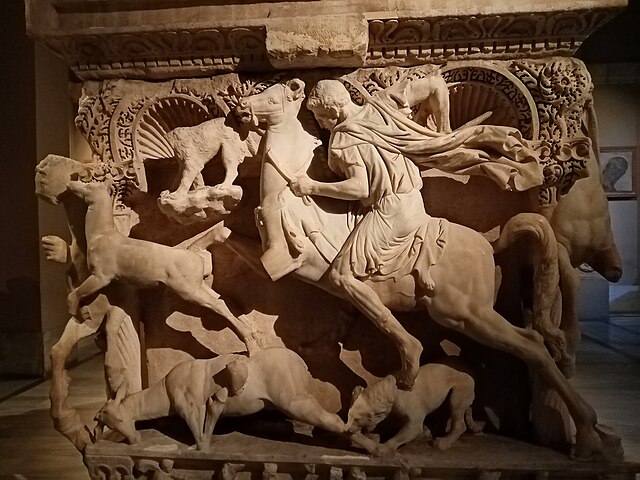
Conclusion and Sources
In conclusion, the Alexander the Great Sarcophagus is a celebrated artifact that has captivated scholars, historians, and art enthusiasts alike since its discovery. Its rich depictions and remarkable state of preservation offer a window into the past, providing valuable insights into the cultural and military history of Alexander’s era. The ongoing discussions and analyses surrounding the sarcophagus underscore its significance as a key piece of our shared global heritage, continuing to inspire and educate future generations.
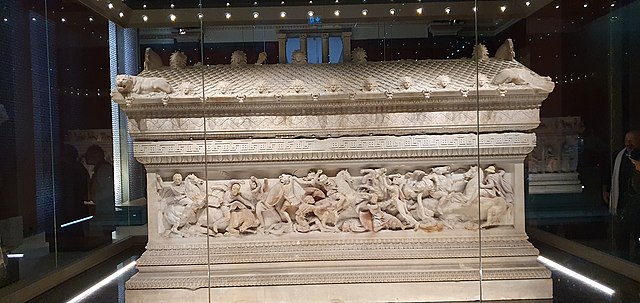
For further reading and to validate the information presented in this article, the following sources are recommended:
Or you can check any of these reputable archaeological and historical texts:
Green, P. (2007). Alexander the Great and the Hellenistic Age. London: Weidenfeld & Nicolson.
Hammond, N.G.L. (1989). The Macedonian State: Origins, Institutions, and History. Oxford: Clarendon Press.
Bosworth, A.B. (2001). Conquest and Empire: The Reign of Alexander the Great. Cambridge: Cambridge University Press.
Smith, R.R.R. (1991). Hellenistic Sculpture: A Handbook. London: Thames & Hudson.

